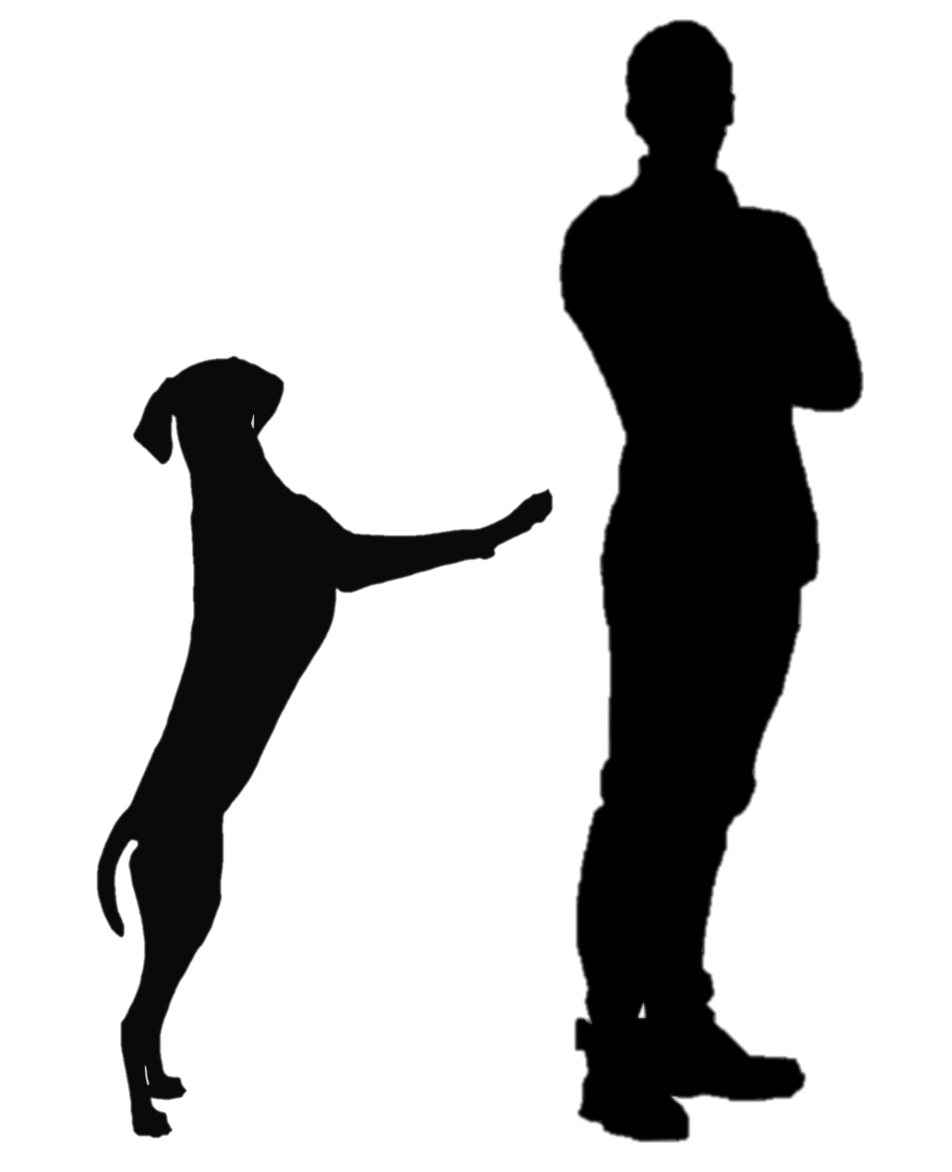What happens in the three-part video below doesn't look too eventful, but for this dog and his owners, it was a big deal.
Oliver had a history of intense barking at his owners when guests were present. These awesome, dedicated guardians had taught him to go to a mat when guests arrived—which was a great incompatible response to jumping on them—but he still barked from the mat while they were visiting unless food was delivered at a fairly high rate. During our first meeting (which was actually about training for his sibling) it was hard to carry on a conversation over his barking.
I don't know why this behavior first occurred, but by the time I came into the picture, it appeared that the barking was likely reinforced by the opportunity to do mat training! (Note: This means that what we did for Oliver may not be what you should try for your dog who barks at guests. If you don’t know why your dog is barking, please work with a professional to assess it and make a customized plan based on that information.)
In the first clip below, with a guest over (me), Oliver is quiet on his mat (as noted below, the first thing we tried was to build duration for that). In the second clip, his mat has been removed, and he begins to bark and look at his dad. In the third clip, his mat is removed, but a towel is placed on a doorknob, and Oliver never barks as he lays down next to his mom, solicits petting from the guest, and (delicate sensibilities warning) demonstrates why one of his nicknames is “the egg man.”
In my experience, it's not unusual for dogs to learn to bark at their owners only when guests are visiting . . . or only when they talk on the phone . . . or, as many of us saw during COVID lockdowns, only when they work over Zoom. That's probably because owners may not reinforce barking consistently when they are home alone with the dog, but may feel extra pressure to do something to immediately quiet a barking dog when they are interacting with another person. The dog may then learn that this is when barking is the most effective way to get a need met.
Often when we repeatedly redirect the dog, rather than arranging the environment proactively to preempt the unwanted behavior, we can actually end up "training" the unwanted behavior in this way. (See: Redirect or Preempt? and Thanks for Barking 2.0.)
This blog post I originally wrote about what we ended up doing for Oliver, back in 2019, got eaten by gremlins (read: I tried to edit it and accidentally deleted most of it) shortly after I put it up. So I’ll sum up quickly here: As previously noted, we first worked on adding duration to a quiet down behavior on the mat. Oliver’s people did an amazing job of this, working up from almost no duration to 15 minutes of quiet between sessions! However, this still felt unsatisfactory—Oliver and his humans were both actively “working” when guests were over, and nobody could just relax and enjoy interacting with the guests, which is the whole point of having guests.
So ultimately, we taught him (a) that when a towel was tied to the doorknob, barking would no longer produce food, specifically the opportunity to earn food by going to his mat, or any other response; (b) when the towel was up, nonfood reinforcers were available for other behaviors, such as petting for approaching a guest, or proximity to a person for hopping up on the couch next to them—both things Oliver seemed to enjoy in other contexts). In the short term, we also used exactly what he was barking to get—food, delivered during mat training—to reinforce the absence of barking for a certain amount of time. Probably thanks to the other reinforcers available, the owners were able to fade the food out, and the last time I checked Oliver was still able to hang quietly and interact with guests without any mat training, and also without the towel.
I have since tried similar procedures with other clients whose dogs barked persistently for food in certain situations, including one case study I presented at ClickerExpo Live in 2021 (as part of Susan Friedman’s talk), as well as with three such dogs for my master’s thesis, Signaled Differential Reinforcement of Other Behavior to Address Excessive Vocalization in Dogs (which should theoretically be available via Proquest, though I can’t find it in search results yet). I hope to write more about that here in the future. In the meantime, though, I have finally found time to try to reconstruct this post.
Around the time of the original publication, I received a polite and important private request for clarification, which I thought would be beneficial to answer at some length in public. Part of the question was essentially, did I use extinction while the towel was on the doorknob?
The answer is yes: The behavior of barking was put on an extinction schedule in the presence of the towel, which in English means that while the towel was out, the owners did not attend in any way to Oliver's barking. Previously they had redirected him to other behaviors when he barked, and more recently if he barked they had waited for some period of keeping his mouth closed and then reinforced quiet. While they had made huge progress on building duration for quiet behavior, (a) it's possible they were actually reinforcing a sequence of behaviors, bark and then be quiet for increasingly longer, and (b) taking this approach still meant that both Oliver and they had to be training when guests were present.
The reason I felt this was important to answer was that, generally speaking, effective and ethical teachers try to minimize both the use of extinction and the negative side effects of extinction when they do use it. The sudden unavailability of reinforcement for a behavior that has been reinforced a lot in the past can be really hard for both the teacher and the learner. If you execute that incompletely or inconsistently, e.g., withholding reinforcement at first but then giving in when (predictably) the learner initially intensifies his efforts (a phenomenon called an "extinction burst"), you are likely to make the unwanted behavior more intense and more persistent. If we had implemented extinction with Oliver without a clear new signal (the towel), I think it's likely we would have seen a pretty big extinction burst, and that all the humans involved would have been quite discouraged by it. (For more on the problem with "ignoring" behavior as a standalone solution, see: The Problem With "Ignoring" Unwanted Behavior.") However, I can't say for sure (and my master's thesis didn't entirely answer the question of how important the new signal was either).
The best time to prevent reinforcement for an undesirable behavior is the first time it happens. If a mystery button appeared on your desk tomorrow and you pressed it, and nothing happened, you probably wouldn't press it again. But if you pressed it and $100 floated down from the sky, you'd damn sure try that again, and probably not give up the first time it didn't work.
After a behavior produces some desirable or useful outcome, not only will it become more likely, but it will become more likely in the context in which it worked. That context is what will come to tell the dog (or person) that reinforcement is likely for that behavior now. E.g., if your teacher asks a question in class for which you have the answer, and you raise your hand, and the teacher calls on you, you may be more likely to raise your hand in the future--but not randomly. You will be more likely to raise your hand when your teacher asks a question, and you have the answer. That's the controlling context.
Oliver didn't bark randomly. He didn't do it when the owners were sitting around in their living room by themselves. He didn't do it outside when the owners visited with people on the street. He did bark when food was being prepared in the kitchen, so food was likely a cue as well as a reinforcer for barking. Guests in the living room were definitely part of the context controlling barking, as were the mat, the treat pouch, the treats, the clicker, and probably even things like the owners' posture or gaze. The first thing I tried was simply removing as many of those cues from the environment as possible--no food, no mat, no clicker, no treat pouch, etc. But guests alone were enough to cue Oliver that barking would work, and we could not remove that cue.
So, you could say that the intention of adding the towel was intended to give Oliver's owners a new "first time." We couldn't change the context by subtraction, but perhaps, I thought, we could add something to that context that would get associated with the new rules for reinforcement.
Some other key details (note: this post should NOT be taken as complete instructions for the procedure):
(1) We started with what I intended to be a low, achievable criterion (30 seconds), and ended up shortly making it even lower (20 seconds), so we could show Oliver very quickly that if he didn't bark during that time, the training setup would reappear. It is likely bringing out the mat and treats, etc., previously reinforced barking; we needed Oliver to see they were available for doing other stuff. Today, I would probably start with just 5 seconds or maybe even less to reduce error. You can also figure out what your first criterion should be by taking a baseline: how long can the dog currently go between barking episodes in the problem context? Make it shorter than that.
(2) If Oliver did bark during that time, all that happened was the clock was reset. There was no pointed sighing, harumphing, or turning away from him to "ignore" (those types of things can actually become cues, and therefore end up reinforcing the behavior); people just kept doing whatever they were doing when he barked. And then it took a little longer for the training setup to come back.
(3) In the presence of the towel, pretty much any other behavior could make things happen that Oliver was known to enjoy in other contexts. He could sniff, look, lie down, jump up on the couch, approach a person, sit next to a person, etc. And while food was off the menu, talking, petting, looking at Oliver, smells, and maybe even a reprieve from interaction were all readily available for a wide range of desirable, behaviors that he already knew how to do. When the time criterion was reached, that stretch of alternative behaviors was additionaly reinforced by the owners bringing the mat back out for a quick round of training with food.
When you have many paths to reinforcement, it probably doesn't feel so harsh if just one of them is not available. A clear signal that reinforcement is not available can likely reduce “frustration” if it's used combination with, and/or doubles as, a clear signal pointing to alternatives for which the animal already has the required skills. Your "closed" sign should say not just, "Sorry, this store is closed" but also "the one down the street is open until 9," and your learner should already know how to get there.
An update on Oliver's behavior with guests:





